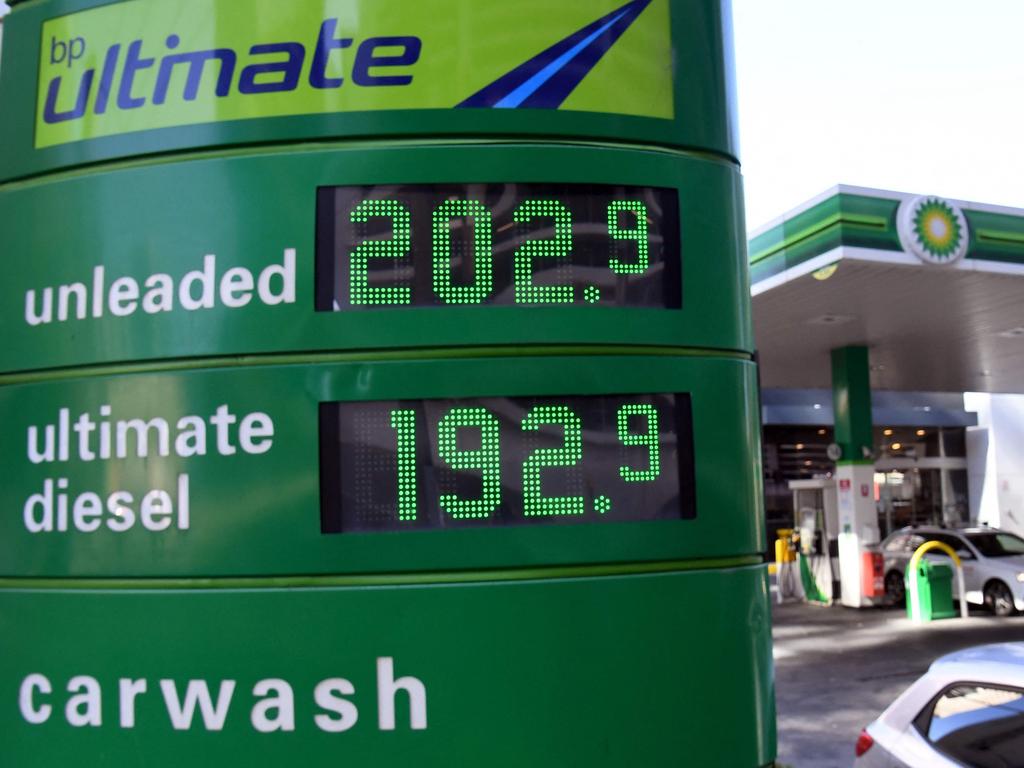When Australian petrol prices could go back to normal
Oil prices have fallen after skyrocketing following Russia’s invasion of Ukraine – but Aussies shouldn’t get too comfortable just yet.
Global oil prices have begun to ease after skyrocketing in the wake of Russia’s invasion of Ukraine – but Aussies shouldn’t get too comfortable just yet.
The price of benchmark brent crude continued to fall overnight, dropping back below $US100 ($A140) per barrel amid hopes of increased supplies from the Middle East and fresh coronavirus lockdowns in China raising expectations of reduced demand.
Brent crude leapt as high as $US139 ($A193) last week after Western countries banned Russian oil exports, stoking fears of a global supply squeeze – with some analysts predicting it could touch $US200 ($A278) per barrel.
Australian motorists are now paying well over $2 a litre at the pump, and experts had warned it could reach $2.50 if the situation continued to escalate.
But the oil price has fallen sharply since last week, dropping about 20 per cent from its high.
Reports on Tuesday that an Iran nuclear deal is back on the cards, as well as indications that OPEC countries including the United Arab Emirates and Saudi Arabia may boost oil production, have eased fears of a supply shock.
“OPEC pointed out in its monthly report that there is no shortage in the oil market,” ANZ said in a note on Wednesday.
“It did warn though that the Ukraine conflict threatens to intensify the surge in global inflation, hurting oil demand and investment.”
The plunge was further driven by China placing nearly 30 million people under Covid-19 lockdown, reflecting worries about the prospects for the world’s second largest economy and a major energy consumer.
“We have good news and we have bad news,” Briefing.com analyst Patrick O’Hare told AFP. “The good news is that oil prices are down sharply … The bad news is that the big drop in oil prices is due to growth concerns which, by extension, doesn’t bode well for earnings growth prospects.”
Rystad Energy analyst Louise Dickson said severe Chinese restrictions could put 500,000 barrels a day of oil at risk.
“China oil demand risk is real,” Ms Dickson told AFP, adding that a strengthening US dollar also pressures crude prices since oil is traded in dollars.
She cautioned that the drop in oil prices may be “short lived” given the tight state of global crude inventories and ongoing uncertainty surrounding Russian crude.
Other experts have similarly cautioned that it’s too early breathe a sigh of relief, with the tumultuous geopolitical environment likely to continue to drive wild swings in the market.
“I wouldn’t rule out $US200 a barrel just yet,” Bjørnar Tonhaugen, head of oil markets at Rystad Energy, told CNN. “It’s too soon. This is the quiet before the storm.”
Rebecca Babin, senior energy trader at CIBC Private Wealth Management, told Bloomberg, “This is a market that is trading on two strong emotions – hope and fear. Neither of those things are going to change supply-demand imbalances.”

What does it mean for Australian motorists?
Mark McKenzie from ACAPMA, the peak body representing Australia’s service stations, said it generally took around two weeks for the oil price to flow through to the petrol pump.
“What we’re seeing is a period of stability – how long it lasts is anyone’s guess,” he said.
“But what it suggests is this week and next week petrol prices should stay near where they are, with likely no significant increase.”
Mr McKenzie said the global oil price was “bouncing around like a yoyo”.
“The volatility is at a level we’ve not seen in recent memory, so drawing conclusions is a little difficult,” he said.
“Two weeks ago we saw a rise in the average wholesale cost of 17 cents per litre between Monday and Friday, last week that was 20 cents per litre. That means I’m trying to find $8000 more for my tank delivery on Friday than on Monday.”
He said the recent fall was expected as the “vertical” rise in the oil price was “just patently unsustainable for the global economy” – but that it was anyone’s guess where things would go next.
“My sense here is we have a short reprieve, because we had a very sharp increase that was basically unsustainable,” he said.
“People are extrapolating off a vertical curve, that’s nonsense. It’s possible that could have kept on going, but it’s also equally possible it will go down.”
Mr McKenzie said even with rising oil prices, motorists could still find a good deal by shopping around as different service station networks purchased fuel on different contracts.
While some use a smoothed average over two or four weeks, others buy on a short horizon, meaning the price tracks the oil price more quickly.
“Pretty soon after the oil price goes up they go up, when it goes down they go down,” he said. “That’s a benefit for them in a falling market. The others are slower to go up and come down. Because you’ve got those different buying styles you’re getting variation in price, which for consumers means they need to be looking around.”
Mr McKenzie said the industry was “ambivalent” about a potential cut in the 44.2 cent per litre fuel excise by the Federal Government.
“It’ll give a sugar hit in terms of providing an immediate drop, but trying to solve a global oil market problem by adjusting an in-country excise is not really a fix,” he said.
“You’re trying to hold back the tide of a global market, a tax change will provide only short-term relief.”
Mr McKenzie said ultimately everything came back to OPEC.
“The government needs to continue to work with the 30 economies in the International Energy Agency, using strategic reserves to pressure the OPEC countries off the bench and get them to ramp up production,” he said.
“The real issue is dealing with the supply-demand imbalance.”
– With AFP






